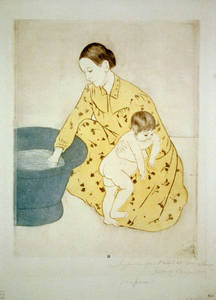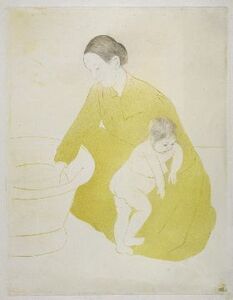Cassatt
First in a Series
Sunday, September 29, 2013

“The Bath,” 1891. State: xvii/xvii: color print with drypoint, softground and aquatint.
On a fleeting visit to the Cleveland Museum of Art late last December – five women of three generations, including the baby and her much-admired five-year-old cousin L. – I caught a first glimpse of something that seemed suddenly very interesting, or rather it was as if I had already for a while been interested and had come upon the occasion when a dim returning attraction becomes a definite line to pursue.
We were a small cloud of Brownian motion bounding and rebounding in that museum’s great atrium, recently-completed, and its great white rooms – it was almost by accident that we found ourselves in a small exhibition of Mary Cassatt’s prints. On one side of a hallway a room with works on paper having to do with life in Paris – something of Degas, something of Toulouse-Lautrec. And on the other side of the hallway the room of Cassatt prints. Their fine yellow, slightly Japanese in tone, women seated, stillness, design. In the different impressions, deliberation. I didn’t have time to look comparatively, and envied the men and women spending a careful hour in that room.
Last weekend, at the Raven bookstore, a find: Mary Cassatt: The Color Prints, by Mathews and Shapiro, for an exhibition in Boston, DC, and Williamstown, 1989-1990. And last night, reading late, found the thought I might have had, or begun to have, that dark December day.
In 1879, at the invitation of Degas, Cassatt began exhibiting with the Impressionists. Later that fall, she made a trip to the Alps – I imagine one of those trips during which vision is clarified and from which one returns full of the energy to redouble one’s efforts. She found that Degas, Pissarro and Bracquemond had the idea for a new print journal, La jour et la nuit. She joined in. “At the moment,” Degas wrote to Bracquemond of the project, “Mlle Cassatt is full of it.”
At the Impressionist exhibition the following spring, Degas, Cassatt and Pissarro showed etchings they had been doing over the winter. Interestingly, they showed early “preliminary” states as well. [The states of an etching are prints made at different stages from the same plate, often there are considerable changes both because the artist may draw and scrape out aspects of the design, and because the plate itself changes and wears in the process of being printed.]
The Impressionists were unusual in valuing preliminary unfinished states, and this bears an important relation to their understanding and depiction of time. As Shapiro and Mathews point out: “States thus must be seen as a larger work of art; in a sense they form a “series” as in other Impressionist groups of related works.” Cassatt, they continue, “keeps reworking the plate and redefining the lights and darks in endless variation as if to capture the changing light of the actual scene.”

